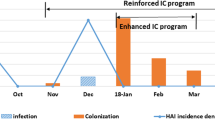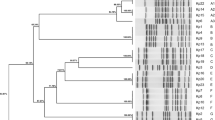Abstract
In the context of a 3-month extended-spectrum beta-lactamase-producing Klebsiella pneumonia (ESBL-KP) outbreak in a neonatal care center (NCC), hygiene practices and hospital environment were investigated. ESBL-KP strains isolated from patients and environment were compared by molecular typing. The density of incidence of multi-drug-resistant bacteria (MDRB) was calculated from January 2014 to September 2016. The 3-month ESBL-KP outbreak involved 19 patients. Clinical strains from the 19 patients displayed the same molecular profile between them, and with a strain isolated from an incubator after cleaning. Furthermore, 52.4% of incubator mattresses were positive for diverse pathogens. Hygiene practices were acceptable except for external practitioners and parents. In addition to classical infection control (IC) measures, the replacement of mattresses and the improvement of incubators disinfection stopped the outbreak. The protocol of disinfection was revised and microbiological control was implemented. A significant decrease of MDRB incidence was concomitant (p value = 0.03219) but 3 months later, MDRB incidence increased again.
Conclusion: This investigation highlighted incubators and mattresses as critical materials associated to infectious risk in NCC. NCC and IC teams should implement efficient protocol for incubators disinfection and monitoring.
What is Known: • Environment in neonatal intensive care units is often suspected as reservoir for Enterobacteriaceae outbreaks but is scarcely investigated. • Incubators and mattresses offer wet and warm conditions suitable for pathogens multiplication, but microbiological survey is not performed routinely for assessing bacterial contamination. | |
What is New: • Incubators and mattresses serve as reservoir for pathogens and relay in outbreak. • An infection control protocol associating efficient disinfection and microbiology analysis is proposed. |



Similar content being viewed by others
Abbreviations
- ESBL-KP:
-
Beta-lactamase-producing Klebsiella pneumonia
- HAI:
-
Healthcare-associated infection
- IC:
-
Infection control
- KP:
-
Klebsiella pneumonia
- MALDI-TOF MS:
-
Matrix-assisted laser desorption/ionization-time-of-flight mass spectrometry
- MDRB:
-
Multi-drug-resistant bacteria
- MRSA:
-
Methicillin-resistant Staphylococcus aureus
- MSSA:
-
Methicillin-susceptible Staphylococcus aureus
- NCC:
-
Neonatal care center
- NICU:
-
Neonatal intensive care unit
- NKU:
-
Neonatal kangaroo unit
- NRU:
-
Neonatal resuscitation unit
- PFGE:
-
Pulsed field gel electrophoresis
- VRE:
-
Vancomycin-resistant Enterococcus
References
APR W (2018) The role of the environment in the spread of healthcare associated infections. J Hosp Infect 100(3):363–364
Bradbury SL, Mack D, Crofts T, Ellison RT III (2014) Potential bloodborne pathogen exposure from occult mattress damage. Am J Infect Control 42(4):421–422
Brooks B, Firek BA, Miller CS, Sharon I, Thomas BC, Baker R, Morowitz MJ, Banfield JF (2014) Microbes in the neonatal intensive care unit resembl those found in the gut of premature infants. Microbiome 2:1
Buffet-Bataillon S, Rabier V, Bétrémieux P, Beuchée A, Bauer M, Pladys P, le Gall E, Cormier M, Jolivet-Gougeon A (2009) Outbreak of Serratia marcescens in a neonatal intensive care unit: contaminated unmedicated liquid soap and risk factors. J Hosp Infect 72(1):17–22
Butin M, Martins-Simões P, Picaud JC, Kearns A, Claris O, Vandenesch F, Laurent F, Rasigade JP (2015) Adaptation to vancomycin pressure of multiresistant Staphylococcus capitis NRCS-A involved in neonatal sepsis. J Antimicrob Chemother 70(11):3027–3031
Carey AJ, Saiman L, Polin RA (2008) Hospital-acquired infections in the NICU: epidemiology for the new millennium. Clin Perinatol 35(1):223–249
Casolari C, Pecorari M, Della Casa E, Cattani S, Venturelli C, Fabio G, Tagliazucchi S, Serpini GF, Migaldi M, Marchegiano P, Rumpianesi F, Ferrari F (2013) Serratia marcescens in a neonatal intensive care unit: two long-term multiclone outbreaks in a 10-year observational study. New Microbiol 36(4):373–383
Cilieborg MS, Boye M, Sangild PT (2012) Bacterial colonization and gut development in preterm neonates. Early Hum Dev 88(Supplement 1):S41–S49
Clarivet B, Grau D, Jumas-Bilak E, Jean-Pierre H, Pantel A, Parer S, Lotthé A (2016) Persisting transmission of carbapenemase producing Klebsiella pneumoniae due to an environmental reservoir in a university hospital, France, 2012 to 2014. Euro Surveill 21(17). https://doi.org/10.2807/1560-7917.ES.2016.21.17.30213
Creamer E, Humphreys H (2008) The contribution of beds to healthcare-associated infection: the importance of adequate decontamination. J Hosp Infect 69(1):8–23
Dalben M, Varkulja G, Basso M, Krebs VLJ, Gibelli MA, van der Heijden I, Rossi F, Duboc G, Levin AS, Costa SF (2008) Investigation of an outbreak of Enterobacter cloacae in a neonatal unit and review of the literature. J Hosp Infect 70(1):7–14
Dancer SJ (2014) Controlling hospital-acquired infection: focus on the role of the environment and new technologies for decontamination. Clin Microbiol Rev 27(4):665–690
de Goffau MC, Bergman KA, de Vries HJ et al (2011) Cold spots in neonatal incubators are hot spots for microbial contamination. Appl Environ Microbiol 77(24):8568–8572
de Oliveira AC, Viana REH, Damasceno QS (2012) Contamination of hospital mattresses by microorganisms of epidemiological relevance: an integrative review. J Nurs UFPE on line 7(1):236–245
Denkel LA, Schwab F, Kola A, Leistner R, Garten L, von Weizsacker K, Geffers C, Gastmeier P, Piening B (2014) The mother as most important risk factor for colonization of very low birth weight (VLBW) infants with extended-spectrum β-lactamase producing Enterobacteriaceae (ESBL-E). J Antimicrob Chemother 69(8):2230–2237
Dubois V, De Barbeyrac B, Rogues A-M et al (2010) CTX-M-producing Escherichia coli in a maternity ward: a likely community importation and evidence of mother-to-neonate transmission. J Antimicrob Chemother 65(7):1368–1371
Dziri D, Klibi N, Alonso CA, Ben Said L et al (2016) Characterization of extended-spectrum β-lactamase (ESBL)-producing Klebsiella, Enterobacter, and Citrobacter obtained in environmental samples of a Tunisian hospital. Diagn Microbiol Infect Dis 86(2):190–193
Fabbri G, Panico M, Dallolio L, Suzzi R, Ciccia M, Sandri F, Farruggia P (2013) Outbreak of ampicillin/piperacillin-resistant Klebsiella pneumoniae in a neonatal intensive care unit (NICU): investigation and control measures. Int J Environ Res Public Health 10(3):808–815
Gallimore CI, Taylor C, Gennery AR, Cant AJ, Galloway A, Xerry J, Adigwe J, Gray JJ (2008) Contamination of the hospital environment with gastroenteric viruses: comparison of two pediatric wards over a winter season. J Clin Microbiol 46(9):3112–3115
Golan Y, Doron S, Sullivan B, Snydman DR (2005) Transmission of vancomycin-resistant Enterococcus in a neonatal intensive care unit. Pediatr Infect Dis J 24(6):566–567
Gouby A, Neuwirth C, Bourg G, Bouziges N, Carles-Nurit MJ, Despaux E, Ramuz M (1994) Epidemiological study by pulsed-field gel electrophoresis of an outbreak of extended-spectrum beta-lactamase-producing Klebsiella pneumoniae in a geriatric hospital. J Clin Microbiol 32(2):301–305
Griffith CJ, Dancer SJ (2009) Hospital cleaning: problems with steam cleaning and microfibre. J Hosp Infect 72(4):360–361
Gupta A (2002) Hospital-acquired infections in the neonatal intensive care unit-Klebsiella pneumoniae. Semin Perinatol 26(5):340–345
Hartz LE, Bradshaw W, Brandon DH (2015) Potential NICU environmental influences on the neonate’s microbiome: a systematic review. Adv Neonatal Care 15(5):324–335
Health C for D and R. Safety Communications - Damaged or Worn Covers for Medical Bed Mattresses Pose Risk of Contamination and Patient Infection: FDA Safety Communication. Available at: http://www.fda.gov/MedicalDevices/Safety/AlertsandNotices/ucm348016.htm. Accessed 12 Nov 2016
Hendrik TC, Voor in ‘t holt AF, Vos MC (2015) Clinical and molecular epidemiology of extended-spectrum beta-lactamase-producing Klebsiella spp.: a systematic review and meta-analyses. PLoS One 10(10):e0140754
Hosein IK, Hoffman PN, Ellam S, Asseez TM, Fakokunde A, Silles J, Devereux E, Kaur D, Bosanquet J (2013) Summertime Bacillus cereus colonization of hospital newborns traced to contaminated, laundered linen. J Hosp Infect 85(2):149–154
Lin R, Wu B, Xu X-F, Liu X-C, Ye H, Ye GY (2012) Extended-spectrum beta-lactamase-producing Klebsiella pneumoniae infection in a neonatal intensive care unit. World J Pediatr 8(3):268–271
Macdonald TM, Langley JM, Mailman T et al (2011) Serratia marcescens outbreak in a neonatal intensive care unit related to the exit port of an oscillator. Pediatr Crit Care Med 12(6):e282–e286
Madani TA, Alsaedi S, James L, Eldeek BS, Jiman-Fatani AA, Alawi MM, Marwan D, Cudal M, Macapagal M, Bahlas R, Farouq M (2011) Serratia marcescens-contaminated baby shampoo causing an outbreak among newborns at King Abdulaziz University Hospital, Jeddah, Saudi Arabia. J Hosp Infect 78(1):16–19
Nakamura K, Kaneko M, Abe Y, Yamamoto N, Mori H, Yoshida A, Ohashi K, Miura S, Yang TT, Momoi N, Kanemitsu K (2016) Outbreak of extended-spectrum β-lactamase producing Escherichia coli transmitted through breast milk sharing in a neonatal intensive care unit. J Hosp Infect 92(1):42–46
Narayan SA, Kool JL, Vakololoma M, Steer AC, Mejia A, Drake A, Jenney A, Turton JF, Kado J, Tikoduadua L (2009) Investigation and control of an outbreak of Enterobacter aerogenes bloodstream infection in a neonatal intensive care unit in Fiji. Infect Control Hosp Epidemiol 30(8):797–800
Pessoa-Silva CL, Meurer Moreira B, Câmara Almeida V, Flannery B, Almeida Lins MC, Mello Sampaio JL, Martins Teixeira L, Vaz Miranda LE, Riley LW, Gerberding JL (2003) Extended-spectrum β-lactamase-producing Klebsiella pneumoniae in a neonatal intensive care unit: risk factors for infection and colonization. J Hosp Infect 53(3):198–206
Pestourie N, Garnier F, Barraud O, Bedu A, Ploy MC, Mounier M (2014) Outbreak of AmpC β-lactamase-hyper-producing Enterobacter cloacae in a neonatal intensive care unit in a French teaching hospital. Am J Infect Control 42(4):456–458
Rastogi V, Nirwan PS, Jain S, Kapil A (2010) Nosocomial outbreak of septicaemia in neonatal intensive care unit due to extended spectrum β-lactamase producing Klebsiella pneumoniae showing multiple mechanisms of drug resistance. Indian J Med Microbiol 28(4):380–384
Romano-Bertrand S, Filleron A, Mesnage R, Lotthé A, Didelot M, Burgel L, Bilak E, Cambonie G, Parer S (2014) Staphylococcus aureus in a neonatal care center: methicillin-susceptible strains should be a main concern. Antimicrob Resist Infect Control 3:21
Sexton JD, Tanner BD, Maxwell SL, Gerba CP (2011) Reduction in the microbial load on hightouch surfaces in hospital rooms by treatment with a portable saturated steam vapor disinfection system. Am J Infect Control 39(8):655–662
Vonberg RP, Weitzel-Kage D, Behnke M, Gastmeier P (2011) Worldwide outbreak database: the largest collection of nosocomial outbreaks. Infection 39(1):29–34
Yu M, Cross K, Petrich A, Fish J (2016) Crib mattress investigation: a quality improvement study to assess mattress cover permeability and bacterial growth in crib mattresses. Am J Infect Control 44(7):837–839
Funding
This work was supported by the University Hospital of Montpellier and the association ADEREMPHA, Sauzet, France.
Author information
Authors and Affiliations
Contributions
LC wrote the first draft of the manuscript and provided environmental sampling and bacteriological analyses; HB made the audit observations and analyzed their results; EJB helped for the interpretation of results from bacteriological analyses; MND contributed to the survey of cases in the NCC wards; AM performed molecular typing on strains; GDB provided antibiotic consumption reports; GC diagnosed cases and contributed to their survey in the NCC wards; SP managed the audit study and the application of preventive measures; SRB managed the environmental investigation, the application of preventive measures, and the writing of the manuscript. All authors have seen and approved the submission of this version of the manuscript and take full responsibility for the manuscript. No authors received any grant or honorarium or payment for producing this manuscript.
Corresponding author
Ethics declarations
Conflict of interest
The authors declare that they have no conflict of interest.
Informed consent
All procedures performed in studies involving human participants were in accordance with the ethical standards of the institutional and/or national research committee and with the 1964 Helsinki declaration and its later amendments or comparable ethical standards. For this type of study, formal consent is not required.
Additional information
Communicated by Patrick Van Reempts
Publisher’s note
Springer Nature remains neutral with regard to jurisdictional claims in published maps and institutional affiliations.
Electronic supplementary material
ESM 1
(DOCX 84 kb)
Rights and permissions
About this article
Cite this article
Cadot, L., Bruguière, H., Jumas-Bilak, E. et al. Extended spectrum beta-lactamase-producing Klebsiella pneumoniae outbreak reveals incubators as pathogen reservoir in neonatal care center. Eur J Pediatr 178, 505–513 (2019). https://doi.org/10.1007/s00431-019-03323-w
Received:
Revised:
Accepted:
Published:
Issue Date:
DOI: https://doi.org/10.1007/s00431-019-03323-w




